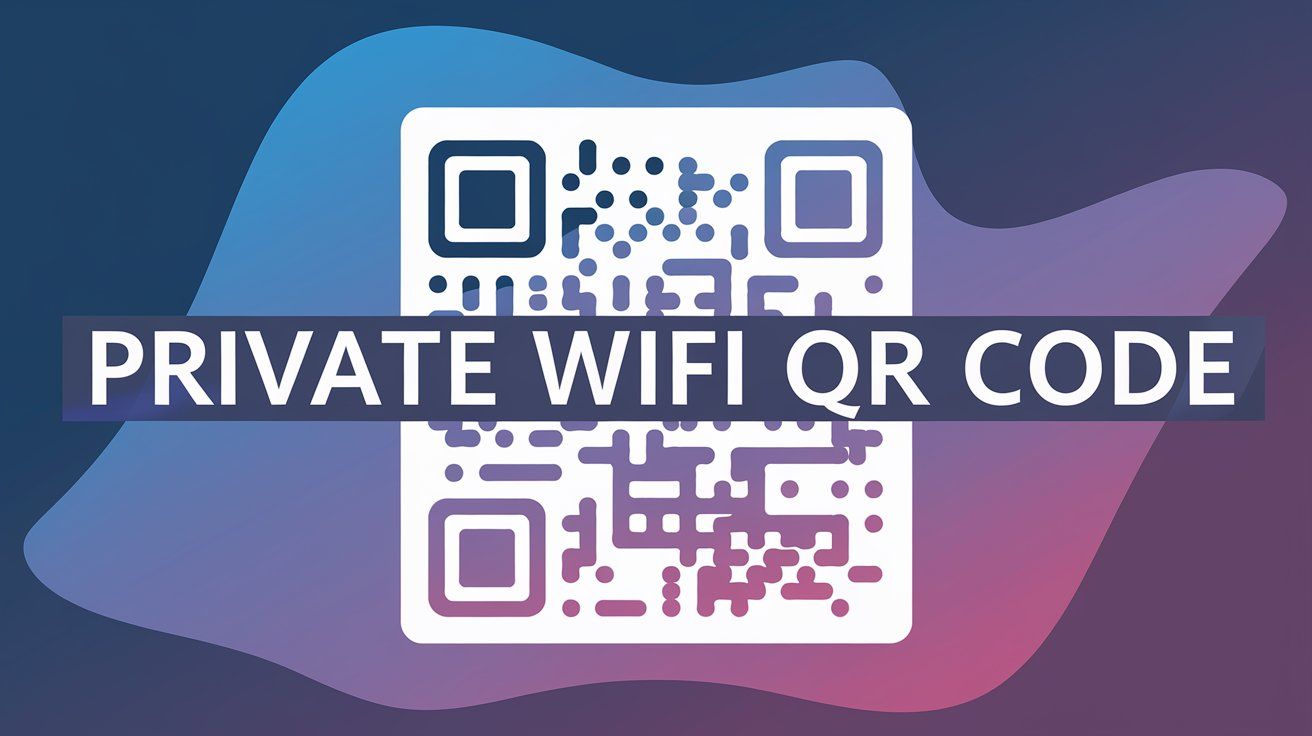How to Create a Private PSK (Pre-Shared Key) Wi-Fi QR Code?

In an age where connectivity is everything, having a secure Wi-Fi network has become a top priority. However, sharing your complex Wi-Fi password with guests, friends, or coworkers can be cumbersome and prone to errors. That’s where a Private PSK (Pre-Shared Key) Wi-Fi QR code comes in handy. By generating a simple QR code, you can allow others to securely connect to your Wi-Fi network with just a quick scan—no need to type long passwords
In this comprehensive guide, we’ll walk you through what a Private PSK is, why you might want to create a Wi-Fi QR code, and how to generate one step by step using qrcode.co.uk. By the end, you’ll have a secure, user-friendly way for guests to access your Wi-Fi without ever manually typing in your password again.
Table of Contents
1. Understanding Private PSK (Pre-Shared Key) Wi-Fi
2. Why Use a QR Code for Wi-Fi?
3. Key Benefits of Using a Wi-Fi QR Code
4. Essential Information Before Creating a Wi-Fi QR Code
5. Step-by-Step Guide to Generating a Private PSK Wi-Fi QR Code
• 5.1. Gather Your Wi-Fi Network Details
• 5.2. Visit qrcode.co.uk
• 5.3. Choose the “Wi-Fi” QR Code Option
• 5.4. Enter Your Wi-Fi Network Information
• 5.5. Customize Your QR Code (Optional)
• 5.6. Generate and Test Your QR Code
• 5.7. Download and Share
6. Security Considerations
7. Tips and Best Practices for Managing Private PSK QR Codes
8. Troubleshooting Common Issues
9. Conclusion
1. Understanding Private PSK (Pre-Shared Key) Wi-Fi
A Pre-Shared Key (PSK) Wi-Fi network uses a single password (also known as the “key” or “passphrase”) that is shared among all users who need to connect. This is common in home networks, small offices, and other environments where simplicity is necessary. Here are a few key points:
• Single Password for All Devices: With a PSK setup, every device uses the same password.
• WPA2 or WPA3 Encryption: Modern networks typically use WPA2 or WPA3 for secure encryption.
• Ease of Use: Because you only need a single password, setting up devices is relatively straightforward compared to enterprise solutions (like WPA2-Enterprise).
For many people, using a PSK is the simplest and most straightforward way to secure a Wi-Fi network—just make sure your password is strong enough (use a combination of letters, numbers, and symbols) to deter unauthorized access.
2. Why Use a QR Code for Wi-Fi?
a) Hassle-Free Connectivity
Typing out a long, complicated Wi-Fi password can be a pain. A Wi-Fi QR code solves this problem: guests simply open their phone’s camera (or a QR code scanning app), point it at the code, and instantly connect without typing anything.
b) Reduced Errors
Humans are prone to typos. A random series of characters (which is recommended for Wi-Fi passwords) is easy to mistype. A QR code ensures that the exact information is transmitted.
c) Modern and Professional
Offering a QR code for your guests to connect to Wi-Fi looks polished and tech-savvy. In offices, cafes, or Airbnb rentals, it lends a touch of professionalism.
3. Key Benefits of Using a Wi-Fi QR Code
1. Enhanced Security: Encourages the use of long, strong passwords without the typical inconvenience of typing them manually.
2. Simplicity: One scan is all it takes—ideal for visitors and short-term guests.
3. Versatility: Works on most modern smartphones and tablets, making it widely accessible.
4. Shareable: You can print the QR code on a sheet of paper, a table tent, or even frame it. You could also share it digitally via email or messaging apps.
4. Essential Information Before Creating a Wi-Fi QR Code
Before you start generating your QR code, it’s essential to have the following details at hand:
• Wi-Fi Network Name (SSID): The exact name of your wireless network, case-sensitive.
• Encryption Type (Security Type): Typically WPA/WPA2 or WPA3 for modern routers.
• Wi-Fi Password (PSK): The full password (often 8+ characters).
With these details ready, you’re set to move forward.
5. Step-by-Step Guide to Generating a Private PSK Wi-Fi QR Code
In this tutorial, we’ll use the services of qrcode.co.uk to create our QR code. qrcode.co.uk offers a straightforward interface and helpful features for customizing your code. Let’s dive in.
5.1. Gather Your Wi-Fi Network Details
As mentioned, you’ll need:
1. The exact SSID (network name).
2. Your Wi-Fi password.
3. The security protocol your router uses (WPA/WPA2 or WPA3).
Make sure you have this information readily available before you begin.
5.2. Visit qrcode.co.uk
Open your preferred web browser and go to qrcode.co.uk. You should land on their homepage, which offers multiple QR code generation options.
5.3. Choose the “Wi-Fi” QR Code Option
On the qrcode.co.uk website, navigate to the Wi-Fi QR code generation section (often labeled as “WiFi” in the menu or homepage). Click on it to open the Wi-Fi QR code creation page.
5.4. Enter Your Wi-Fi Network Information
You’ll be prompted to fill in details about your Wi-Fi network:
1. SSID: Enter your Wi-Fi network’s name exactly as it appears on your devices.
2. Encryption/Security Type: Select the security protocol (WPA, WPA2, WPA3, etc.) that your network uses.
3. Password: Carefully type your Wi-Fi password. If you’re using a password manager, you can copy and paste it here to avoid typos.
Double-check your entries, as any mistake here will result in a non-functional QR code.
5.5. Customize Your QR Code (Optional)
Many QR code generators, including qrcode.co.uk, offer some customization options. You can:
• Change Color: Instead of a traditional black-and-white QR code, you might pick a color that complements your environment.
• Add a Logo or Icon: If you want to brand your QR code, you can sometimes add a small image in the center.
• Adjust Error Correction Levels: The higher the error correction, the more robust the QR code is against smudges or partial obstruction, but it may appear more complex visually.
Keep in mind that while customization can look stylish, adding too many design elements might make the QR code harder to scan. Strike a balance.
5.6. Generate and Test Your QR Code
Once you’ve input all necessary details and chosen your customization options, click the “Generate QR Code” or equivalent button. You’ll see a preview of your newly created Wi-Fi QR code.
Testing is Crucial
1. Open Your Smartphone’s Camera or QR Code Scanner
2. Scan the Code
3. Check Connectivity: Your phone should automatically connect to the specified Wi-Fi network without asking for a password.
If the connection fails, ensure that:
• Your Wi-Fi details were correctly entered (SSID, password, security type).
• You’re physically within range of your Wi-Fi signal.
• Your device supports scanning Wi-Fi QR codes (most modern smartphones do).
5.7. Download and Share
Finally, download the QR code image in your preferred format (PNG, SVG, or JPEG). You can then:
• Print It: Stick it on your fridge, desk, or lobby reception area for guests to scan.
• Email It: Forward the image to coworkers or friends.
• Embed It Online: If you run a business website or a digital guestbook for rentals (e.g., Airbnb), you can embed the QR code so visitors can scan it upon arrival.
6. Security Considerations
While Wi-Fi QR codes simplify the process of connecting to your network, keep these points in mind to maintain security:
1. Strong Passwords: Make sure your Wi-Fi password is robust—long, with a mix of characters.
2. Distribution Control: Only share or display the QR code where authorized users can access it. If posted publicly, it defeats the purpose of having a secure network.
3. Regular Password Updates: Consider changing your PSK every few months. Update your QR code accordingly.
4. Backup: Keep a secure digital copy of your QR code and your password in a password manager or secure location.
7. Tips and Best Practices for Managing Private PSK QR Codes
• Use a Dedicated Guest Network: If your router supports multiple SSIDs, consider creating a separate guest network. That way, your primary network’s password remains protected.
• Label Your QR Code: Write “Guest Wi-Fi” or “Scan to Connect” near the code to guide visitors.
• Monitor Network Usage: Keep an eye on who is using your network. Most modern routers have built-in admin panels with usage logs.
• Periodic Updates: If you suspect unauthorized users, or if many guests have connected over time, update the password and generate a new QR code.
8. Troubleshooting Common Issues
Issue 1: QR Code Not Scanning
• Possible Causes: Poor print quality, low contrast (e.g., light color on a light background), or too much customization.
• Fix: Reprint at higher resolution, use a standard black-and-white pattern, or reduce stylized design elements.
Issue 2: Devices Can’t Connect After Scanning
• Possible Causes: Incorrect SSID, password, or security type.
• Fix: Double-check your Wi-Fi details and generate a new QR code. Ensure the code’s data matches your router’s settings exactly.
Issue 3: Network Name Doesn’t Show Up
• Possible Causes: Hidden SSID.
• Fix: Manually reveal or broadcast your network SSID, or instruct users to use an advanced QR code scanning app that supports hidden networks.
Issue 4: Outdated QR Code
• Possible Cause: You changed your Wi-Fi password or renamed the SSID but didn’t update the QR code.
• Fix: Generate a new code reflecting the current network settings.
9. Conclusion and sumup
Creating a Private PSK (Pre-Shared Key) Wi-Fi QR code provides a seamless way for friends, visitors, or customers to access your network. By taking advantage of a user-friendly generator like qrcode.co.uk, you can quickly produce a code that makes connecting as easy as point-and-scan.
Remember to:
• Keep your Wi-Fi password strong.
• Update your password (and QR code) regularly.
• Only share your QR code where it’s needed.
With that, you’ll strike the perfect balance between convenience and security, ensuring your home or office network remains both user-friendly and well-protected. Happy scanning!

